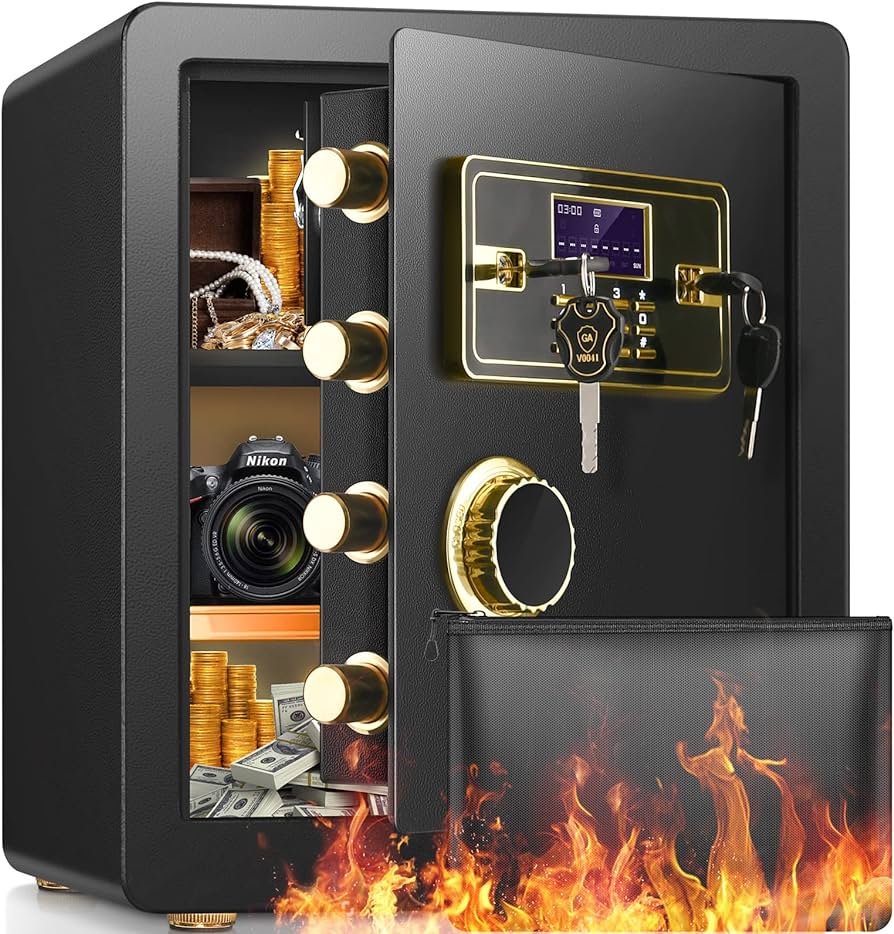Gun safes are generally not airtight, as they require some air circulation to prevent moisture buildup. Understanding the ventilation design of your gun safe is crucial for firearm preservation.
Gun safes serve as a secure storage solution for firearms, offering protection against theft, unauthorized access, and potential damage. A common misconception is that these safes are completely airtight; however, this is not typically the case. Their design usually includes some form of air circulation system to help control humidity and prevent the damaging effects of moisture on guns and ammunition.
Ensuring your firearms are stored in a controlled environment is essential in maintaining their condition and functionality. Many gun owners invest in dehumidifiers or moisture-absorbing products to maintain optimal conditions within the safe. Recognizing that gun safes balance security with proper air circulation helps owners make informed decisions about safeguarding their firearms.

Credit: www.safeandvaultstore.com
Assessing Air Tightness In Gun Safes
When storing firearms, the question of whether gun safes are airtight often arises. This aspect is critical for multiple reasons, such as preventing moisture-related damage. In this section, we’ll delve into how to assess a gun safe’s airtightness and separate fact from fiction on this important feature.
Design Intent For Gun Safe Seals
Gun safes are not designed to be completely airtight. Their seals aim to keep out dust and reduce moisture. This is to help prevent rust and corrosion on firearms. Still, some air circulation is necessary to control humidity within the safe. Proper seal design manages environmental factors. Yet, it allows the safe to “breathe”.
Common Myths About Gun Safe Sealing
Many believe gun safes must be airtight to provide protection. Others think airtight safes prevent humidity damage. These are misconceptions. A truly airtight safe could actually create more harm than good. It might trap moisture inside. It might also create an environment ripe for rust to develop. It is crucial to have a balanced environment.
| Feature | Intended Use |
|---|---|
| Seals | Keep out dust and dampness, not entirely airtight |
| Vents | Allow air flow to control internal environment |
Regular inspection helps ensure seals are intact. If in doubt, consult a professional. They can assess your safe’s sealing and make recommendations as necessary.
Potential Hazards Of Airtight Storage
Potential hazards are crucial to consider when storing firearms in gun safes. Many gun owners believe that sealing their firearms in an airtight safe will provide the ultimate protection. Yet, airtight environments can lead to unintended problems that compromise both the safe’s contents and its purpose. Understanding these risks is key for gun owners.
Risks Of Moisture And Mold
Airtight gun safes seem ideal for keeping out external elements. In reality, they trap moisture inside.
- Moisture builds up without circulation.
- Trapped humid air becomes the perfect breeding ground for mold.
- Corrosion and decay threaten firearms and ammunition.
To combat moisture:
- Use desiccants to absorb unwanted dampness.
- Place a dehumidifier inside the safe.
Regular checks ensure a dry, mold-free environment, safeguarding investments in firearms and keeping them in ready-to-use condition.
Implications For Firearm Maintenance
Failing to maintain firearms ravages their value and utility. Even in an airtight safe, vigilance is key.
| Action | Reason |
|---|---|
| Inspections | Prevent mold and corrosion |
| Cleaning | Ensure optimal functionality |
Manufacturing Standards And Materials
The quality of a gun safe hinges on its manufacturing standards and the materials used. Gun owners seek safes that offer robust protection against theft, fire, and sometimes even water damage. But are these safes airtight? Understanding the manufacturing nuances is crucial to answer this question.
Materials Used In Seal Construction
To achieve a seal that withstands external elements, gun safes employ diverse materials in their construction.
- Steel – offers durability and drill resistance.
- Palusol® – a heat-expanding seal for fire protection.
- Rubber gaskets – commonly used for waterproofing.
Manufacturers often combine these materials to enhance the safe’s sealing capabilities.
Industry Standards For Gun Safe Manufacturing
Industry benchmarks guide the production of safes. Compliance with these standards is essential for consumer trust.
| Standard | Description |
|---|---|
| UL Ratings | Measures resistance to fire and burglary. |
| ASTM Standards | Covers material and performance specifications. |
| ISO 9001 | Ensures quality management systems in place. |
Adherence to these benchmarks is a sign of a high-quality safe. It’s not just about being airtight; it’s about meeting a set of well-defined criteria for overall safety and reliability.

Credit: www.amazon.com
Technical Features Of Modern Gun Safes
Modern gun safes are not just metal boxes. They are advanced security ecosystems. Essential for responsible gun ownership, these safes come packed with features. Let’s explore the technical aspects that set them apart.
Fireproofing And Seal Integrity
A chief concern for gun owners is protecting their firearms from fire. Modern gun safes excel in this task. They feature layers of fire-resistant materials. These compounds keep the interior cool, despite outside heat.
- Fireboard layers insulate the walls.
- They withstand temperatures up to 1,400°F.
- Heat-activated door seals expand to block heat and smoke.
Quality safes have fire ratings. These ratings tell how long contents stay safe during a fire.
Built-in Humidity Control Solutions
Internal humidity is a silent enemy for guns. Excessive moisture causes rust and damage. Advanced gun safes tackle this problem head-on.
Many models include built-in dehumidifiers or electronic humidifiers. They work to maintain a stable environment. This feature is crucial for long-term firearm storage.
| Humidity Control Feature | Benefits |
|---|---|
| Integrated hygrometers | Monitor internal conditions |
| Rechargeable desiccant packs | Adsorb excess moisture |
| Automatic dehumidifiers | Adjust levels actively |
Proper Safe Maintenance And Storage Best Practices
Keeping your gun safe in top condition is key to ensuring the safety and longevity of your firearms. It’s not just about locking them away; it involves regular checks and appropriate storage measures. Let’s delve into the essential steps every gun owner should follow to maintain their safe’s effectiveness.
Regular Inspection For Air Tightness
Check your safe for airtightness to guard against moisture. This can cause rust and damage to firearms. A simple yet effective way to test this is with a thin piece of paper. Place it where the door meets the frame and close the door. If the paper pulls out easily, your safe may not be airtight.
Best Practices For Preserving Firearm Conditions
To maintain your firearms in pristine condition, follow these guidelines:
- Control humidity levels inside the safe using dehumidifiers or silica gel packs.
- Store guns unloaded and ensure they’re clean and oiled before placing them back in the safe.
- Use gun socks or silicone-treated sleeves to prevent scratches and rust.
- Regularly clean the interior and exterior of the safe with a dry cloth to prevent dust accumulation.

Credit: www.safeandvaultstore.com
Alternatives And Solutions For Gun Storage
When it comes to gun storage, safety and proper conditions are essential. Gun safes are not typically airtight, and that can be a good thing. If you tightly seal firearms in an enclosed space, humidity can build up. This moisture can lead to rust and damage. But there are alternative storage options and solutions that protect your guns while keeping them in top condition.
Non-airtight Safe Options
Finding the right balance between security and air circulation is crucial. Non-airtight safes offer that middle ground. These safes ensure that air flows to prevent moisture buildup. They also provide adequate security against unauthorized access. Here are options to consider:
- Gun Cabinets: Often made of steel or wood, these cabinets provide a basic level of security with less focus on sealing out air.
- Lockable Gun Racks: For quick access and display purposes while maintaining basic protection.
- Gun Cases with Locks: Easy to transport and good for temporary storage, with the added benefit of preventing moisture accumulation.
Supplementary Products For Moisture Control
Even within non-airtight safes, maintaining low humidity is vital. Safeguards should be put in place to keep firearms dry. Here’s what you can add to your storage solution:
- Desiccant Packs: Silica gel packs are simple and effective at absorbing excess moisture.
- Electric Dehumidifiers: Compact devices designed to maintain the optimum humidity level inside a safe.
- Corrosion Inhibitors: These emit a vapor that settles on metal surfaces, providing a barrier against moisture.
By selecting a non-airtight safe and enhancing it with moisture control products, your guns can stay secure and in prime condition. Balance the elements and your firearms will be ready for use whenever you need them, in their best form.
Frequently Asked Questions Of Are Gun Safes Airtight What You Need To Know
Are Gun Safes Watertight?
Some gun safes are designed to be watertight, offering protection against water damage. However, not all gun safes have this feature, so it’s important to check the manufacturer’s specifications before purchase.
Is A Fireproof Safe Airtight?
Most fireproof safes are not completely airtight, as they need to allow for pressure equalization during a fire. Some models, however, may offer a degree of airtight sealing for added protection against smoke and water damage.
Can Someone Break Into My Safe?
Yes, safes can be breached, but high-quality models with advanced security features significantly reduce this risk. Proper installation and use of robust locking mechanisms increase your safe’s security.
Should I Put A Mat Under My Gun Safe?
Yes, placing a mat under your gun safe can prevent moisture buildup and protect your floor from scratches or damage. It also aids in noise reduction and stabilizes the safe.
Conclusion
Understanding gun safe features is crucial for proper storage. Not all safes are airtight, impacting gun longevity and condition. Research and select the right safe for your needs. Protect your firearms from elements effectively. Stay informed, prioritize safety, and invest responsibly in gun security.



